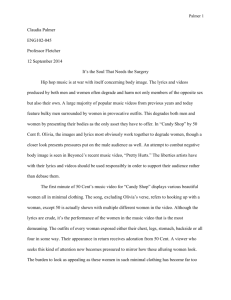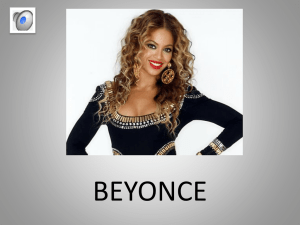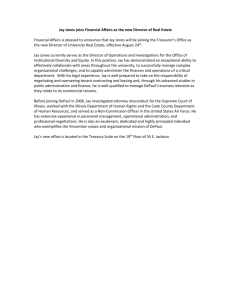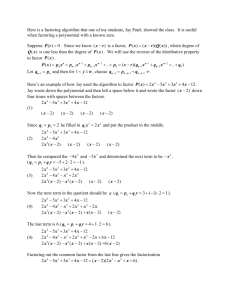File - Julia Malloy Hurt
advertisement
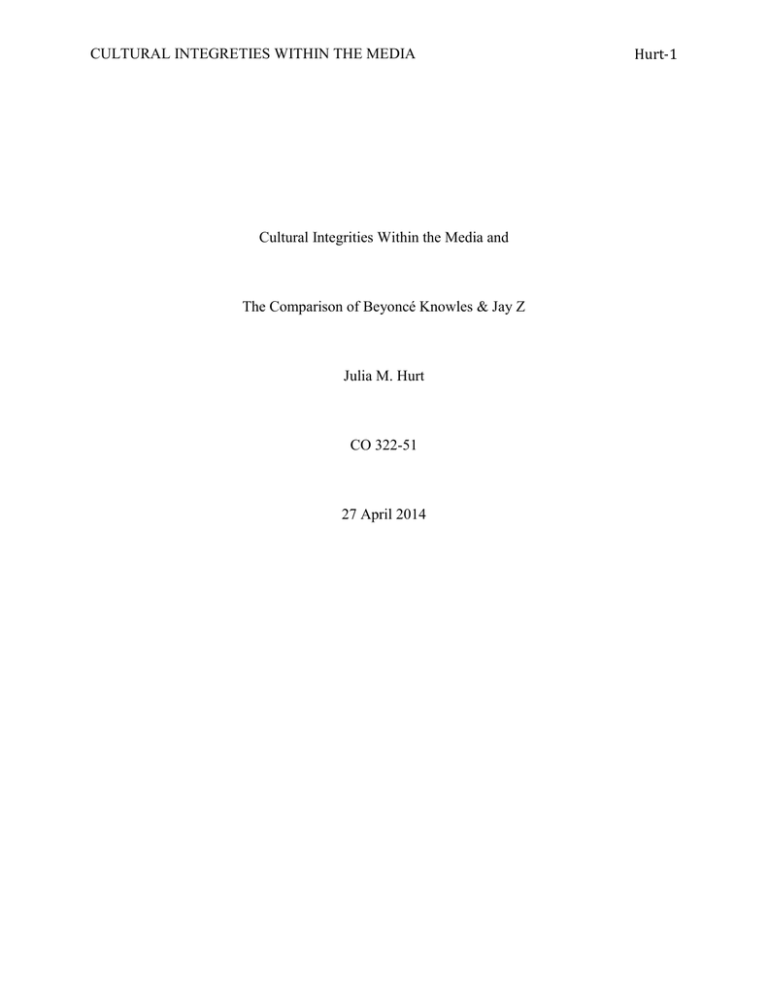
CULTURAL INTEGRETIES WITHIN THE MEDIA Cultural Integrities Within the Media and The Comparison of Beyoncé Knowles & Jay Z Julia M. Hurt CO 322-51 27 April 2014 Hurt-1 CULTURAL INTEGRETIES WITHIN THE MEDIA Hurt-2 Abstract This paper explores articles that expose how the media represents two highly influential musicians of the opposite gender. Although the media is a pervasive and profoundly influential socializing force, our cultural manipulates the portrayal of each gender when pertaining to artist in the music industry. Beyoncé Knowles is multi-platinum, Grammy Award-winning recording artist who is much admired for her exhilarating vocals, videos, and lives shows. While her husband, Jay Z is one of the world’s best-selling artists of all time and is known for his poetically controversial and influential rap/hip hop lyrics. This power couple dominates the music industry, and has the capacity to change social norms whenever they please. The comparison of these two leading music artists in the country is noteworthy. Not only are both of these artists African American, but also they both produce relatively the same genre of music, and reach towards the same general target audience. These two entities are married, hold reasonably the same status in the industry, and have often many times incorporated each other in their work. As I have mentioned the various similarities between the supremacy couple, are both individuals truly viewed and portrayed equally within the mass media? This paper examines the research behind whether or not this phenomenon is an issue within our cultural or if it pertains to gender. This is manifested when comparing all aspects of these individuals’ lives such as; news stories, websites, photographs, magazine covers, album covers, song lyrics, and music videos. It is through these examples that we notice the difference between how the media values and portrays each person. CULTURAL INTEGRETIES WITHIN THE MEDIA Hurt-3 When researching both Jay Z and Beyoncé on Google, it is challenging to find any substantial information regarding either of them. Google filters websites by what page is visited most frequently, and the ten tops pages for both of them concern biographies, social medias, gossip, celebrity news, and scandals— mostly information with no educational value. However, it is significant to realize that there is a difference within the media of how both of these individuals are being portrayed. What is emphasized in the media alternates for both individuals when it comes down to professionalism, attractiveness, family, work, and other aspects in their lives. Beyoncé has always advocated to empower women, and to take away the spotlight on the two roles for women of being a wife and a sexual object. She is very successful, but also very contradicting in this sense. She campaigns against the media portraying and deeming women as sexual objects, but in return she is identified as a sexual object. A recent and global example is when Beyoncé participated in a cover photo shoot for GQ (men’s magazine) right before the Super Bowl of 2013. The article relating to her pictures includes a first sentence stating, “Beyoncé is ready to receive you”(Wallace, 1). Of course this sentence is meant for relation to football, but what else does it imply? Along with her more than half naked pictures, she was deemed as a sexual icon to advertise for the 2013 Super Bowl. Referring to her other concept of empowerment, and women not only be viewed as wives, her latest tour is titled Mrs. Carter (Dockterman, 1). Using her husband’s last name for a tour that has been controversially considered one of the most feministic millennial tours in her genre of music. For a woman who fights strongly against the media’s tendencies of poorly portraying women, she is not one to be held accountable or creditable for her same actions that help the media continue their endeavors of labeling women. CULTURAL INTEGRETIES WITHIN THE MEDIA Hurt-4 The article The Feminine Mystique, by Betty Friedan relates to how Beyoncé is helping the mass media depict women. As Friedan states, “The image of woman that emerges from this big, pretty magazine is young and frivolous, almost childlike; fluffy and feminine; passive, gaily content in a world of bedroom and kitchen, sex, babies, home… the only goal a woman is permitted in the pursuit of a man”(Friedan, 36). When analyzing Beyoncé’s magazine covers, it is rare to find a picture where she looks dominating. In almost all of her pictures, the camera is focused on the position of her body. This is relatable to Friedan’s conclusion of childlike poses. Showing the difference between her thin waste, and wide hips, large buttocks and breast. In almost all her published photos for Vogue, GQ, Essence, Cosmo, Allure, she has a seductive passive emotion on her face, or she is not directly looking at the camera. She is viewed as submissive, but through her work she tries to be dominate stating what is right for a women to do and what is not. Her latest album coincides with what Friedan states about women pursing men, except Beyoncé provides what women should be doing for their man. This is exemplified in her song Partition, where simple submission to “your man” is what a female needs to do. She continues to imply within her lyrics, that it is important to please your man. Yet again, another example of how Beyoncé is portraying herself within the media, and how it is adding to the media portrayal of women. The reason I pointed this altercation out, is for individuals to realize that maybe it is not the media who is portraying this female in a certain way, rather Beyoncé using her features to emphasize herself in the media. This is once again apparent in her most recent song titled, Partition. Bill O Reilly, an American television host states, “Partition’s music video, is a raunchy homage to strippers that completely lacks class, an abrupt departure from earlier, tasteful work”(Sheffield, 1). After watching this music video, the scenes truly do mimic a car picking up CULTURAL INTEGRETIES WITHIN THE MEDIA Hurt-5 a hooker. As many people have negatively commented on Beyoncé’s extreme exploitation of herself, she released an interview, “Self-Titled Part 4. Liberation” stating, Yes. I was very aware of the fact that I was showing my body. I was 195lbs when I gave birth. I lost 65 lbs. I worked crazily to get my body back. I wanted to show my body. I don’t at all have any shame about being sexual and I am not embarrassed about it. I don’t feel like I have to protect that side of me, because I do believe that sexuality is a power that we all have (Beyoncé). Sexuality is powerful, it is used within our media to manipulate, advertise, and skew images of women. The media portrays Beyoncé as this sexual figure that is attempting to redefine feminism, yet is contradicting her actions when doing so. Beyoncé is admired for her work because it is cohesive with the social norms within our society. She is identified as these powerful women who is viewed as her own person, but when researching her there is no evidence of this. Her albums covers continue to portray her with barley any clothes—because we know, sex sells. Her music videos incorporate lingerie, hooker scenes, and her dancing for her husband at a strip bar. Beyoncé cries for equality, defines feminism in her song titled “Flawless”, but exploits her female sexuality to make millions. The articles concerning Beyoncé did not seem sexiest to me because I view her a women who uses her sexuality to be successful within the music industry. Every article about Beyoncé, even in Forbs Magazine and New York Times revolves around discussing her sexuality. The media does not focus on her accomplishments or her work for what it is, rather, how attractive she is, and what more she can do by being sexual. Conversely, Beyoncé’s husband Jay Z is comparably portrayed differently within the media. The articles concerning him are mostly related to his work. For example, he participated in two marketing strategies involving Samsung and Bing. Due to his success of marketing his new book and music, multiple articles are extensively viewed causing a higher popularization of CULTURAL INTEGRETIES WITHIN THE MEDIA Hurt-6 feed through social networks and search engines. Jay Z is known for his work. His album covers consist of either smoothly designed architectures, and occasionally images of him with the camera facing up—deceived in a god-like posture. Jay Z’s intelligent lyrics relate to history, and famous pictures. For example, Natalie Robehmed a forbs journalist wrote an article tilted, JayZ’s Magna Carta Lyrics: A $493 Million Art Collection, stating “Jay-Z’s 12th studio album, Magna Carta Holy Grail, his most artistically inclined, overflowing with references to artwork— around $493 million worth”(Robehmed, 1). His work is clever, and unusually compared to most rappers who converse about sex, women, and drugs. Not only has Jay-Z proven himself within his lyrics, but also his ability to become an entrepreneur and provide advice to his audience by selling his book, Empire State of Mind. The media, such as articles from Forbs, New York Times, Huffington Post, and many more have written all about his entrepreneurial mindset. Focusing on his accomplishments, where he has come from, to where he is now. This in comparison to his wife Beyoncé is not the same. Her work relates to sexuality, while his is more content based focusing on his accomplishments and his style. When comparing both of these individuals’ websites, Jay Z’s contains content, his songs, lyrics, biographies, his family members, who is in his life, and mostly focusing on his work and the achievements he has accomplished. While Beyoncé’s, is literally a collage of photos, with no content unless one were to clink on a link. In magazine covers, Jay Z has been featured in Time, Rolling Stones, GQ, XXcLusive, with dominating photos—emphasizing his importance within the music industry. The articles I analyzed on both persons are from the same notoriously known websites as I mentioned earlier. The difference is the content that each article provides. This is relatable to what we have learned in class. Although this may seem as a gender issue in the mass media, it CULTURAL INTEGRETIES WITHIN THE MEDIA Hurt-7 actually pertains to how our culture perceives gender. Culturally, we live in a society where males have been dominating in various aspects of society, such as; the work force, education, wealth, and power. Fortunately, this is gradually changing due to female’s pursuing equal opportunities that are constantly challenging their gender. It is fascinating how Jay Z and Beyoncé are both equally successful in the same career field, but are portrayed differently in the media. Sexism still exist currently in society Resources: CULTURAL INTEGRETIES WITHIN THE MEDIA Hurt-8 Beyonce Album Covers . (n.d.). Discography . Retrieved from, http://www.mtv.com/artists/beyonce/discography/ Beyonce Official Website . (n.d.). Beyonce . Retrieved from, http://www.beyonce.comess Dockterman, E. Flawless: 5 Lessons in Modern Feminism From Beyoncé. Opinion . Retrieved from, http://time.com/1851/flawless-5-lessons-in-modern-feminism-from-beyonce/ Forbes, S. Jay-Z: A Lesson On The Power Of Entrepreneurial Capitalism. Forbes. Retrieved from http://www.forbes.com/sites/steveforbes/2012/09/05/jay-z-and-the-power-of-entrepreneurialcapitalism/ Friedan, B. (1963). The Happy Housewife Heroine . The feminine mystique (). New York: W.W. Norton. Jay, Z. (n.d.). Jay z online . Jay Z Official Website , Retrieved from, http://www.jayzonline.com/main.php Jay Z Latest Albums. (n.d.). MTV Artists. Retrieved from, http://www.mtv.com/artists/jay-z/discography/ Knowles, B. (2014, January 1). "Self Titled" Liberation Part 4. Retrieved from, http://www.youtube.com/watch?v=pZ12_E5R3qc Parales , J. (2013). Jay-z is watching, and he knows your friends. New York Times , Retrieved from, http://www.nytimes.com/2013/07/05/arts/music/jay-z-is-watching-and-he-knows-yourfriends.html?_r=0 Robehmed, N. Jay-Z's Magna Carta Lyrics: A $493 Million Art Collection. Forbes. Retrieved from http://www.forbes.com/sites/natalierobehmed/2013/07/16/jay-zs-magna-carta-lyrics-a-493million-art-collection/ Sescu, A. (2013). Decode jay z. Bing, Retrieved from, CULTURAL INTEGRETIES WITHIN THE MEDIA Hurt-9 http://lurnq.com/lesson/Decode-Jay-Z-with-Bing-Case-Study/ Sheffield, C. (2014, March 18). Beyonce's Latest Moves Are Holding Women Back. Forbes. Retrieved from, http://www.forbes.com/sites/carriesheffield/2014/03/18/beyonces-latest-moves-are-holdingwomen-back/ Wallace, A. Miss Millennium Beyoncé GQ February 2013 Cover Story. GQ Magazine, Retrieved From, http://www.gq.com/women/photos/201301/beyonce-cover-story-interview-gq-february-2013
